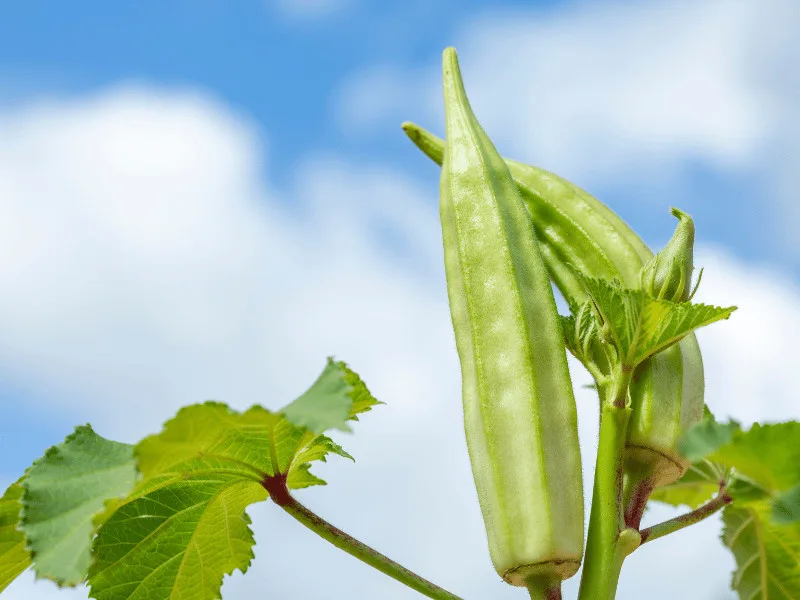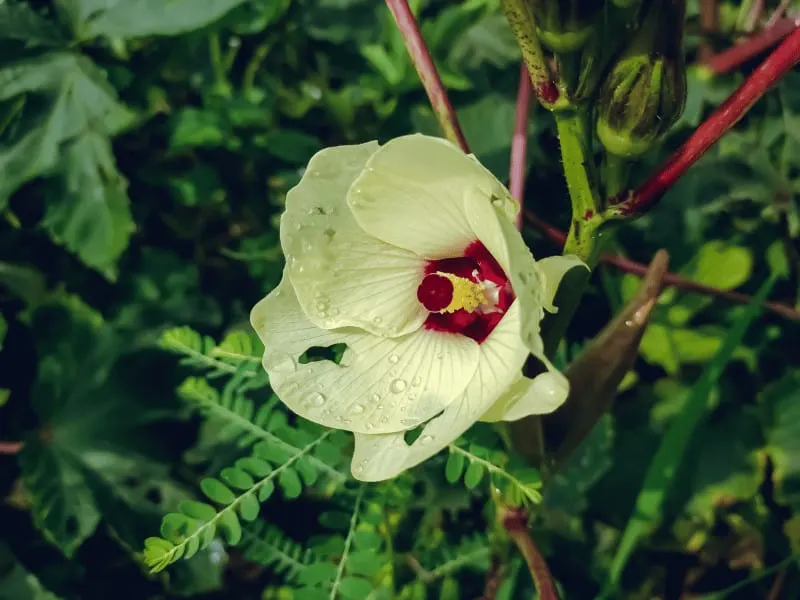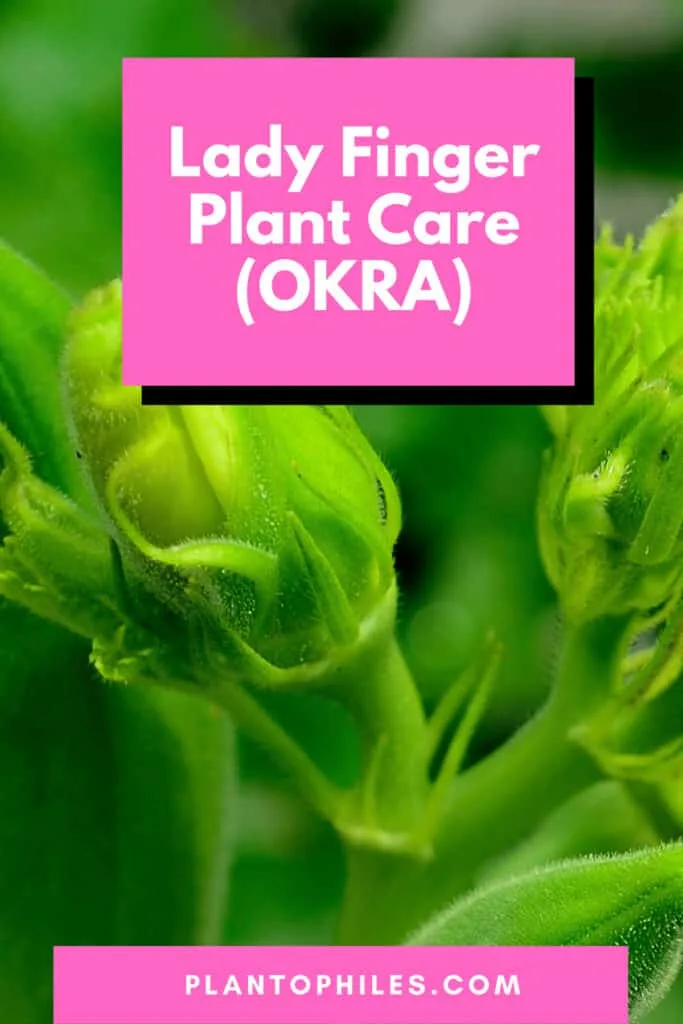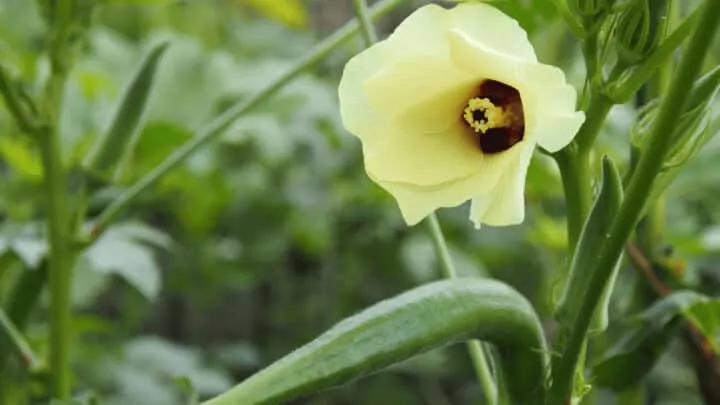You are reading this article to know more about the Lady Finger Plant (Okra) and its care.

What is a Lady Finger Plant (Okra)?
The LadyFinger Plant (Okra) goes by the botanical name Abelmoschus esculentus and belongs to the mallow family according to NC State Extension.
Many home gardeners with vegetable patches like to grow Lady Finger Plants (Okra). It is a vegetable that communities across the world eat with relish. The baby leaves of the plant are edible, too, whereas the roasted seeds are a coffee substitute.
Some might find it a bit distasteful, mainly due to the slime factor in the pod. However, it is a thumping favorite in some world cultures, like in India and in the Deep South of the US and the Caribbean, where it goes into making the famous gumbo.

It is believed that the origins of the Lady Finger Plant (Okra) are in West Africa and South Asia. Nowadays, it is grown even in the Mediterranean, Central American, and Caribbean regions. Note that it is indeed a very tropical/subtropical plant.
Learn more about the Lady Finger Plant (Okra) care requirements.
| Species | Abelmoschus esculentus |
| Synonyms | Lady's Fingers, Okra, Gumbo |
| Family | Malvaceae |
| Genus | Abelmoschus |
| Growth | Compact, Upright |
| Height | 6.0 feet |
| Width | 3.0 feet |
| Soil | Well-draining soil mix |
| Watering | Minimum: 5.0, Maximum: 7.0 |
| Light | Full sun |
| Temperature | Minimum: 65.0°F (18.3°C), Maximum: 85.0°F (29.4°C) |
| Humidity | Minimum: 40.0%, Maximum: 60.0% |
| Fertilizer | Side dress after 5 weeks |
| Propagation | Propagate by seeds or stem cuttings |
| Toxicity | Unknown |
| Flower | Yellow flowers with purplish centers. They look like hibiscus flowers. |
Table of Contents
Lady Finger Plant Care (Okra)
You can grow Lady Finger Plant (Okra) in your garden as an annual germination from seeds, i.e., a single-season plant. Okra care requires organic nutrient-rich soil, a full blast of sun morning to evening, high temperatures ranging between 68°F – 113°F (20°C – 45°C), and constant moisture. An out-and-out, light and heat-loving tropical plant.

Soil
Lady Finger Plant (Okra) care is surprisingly simple when it comes to soil. It can grow in just about any soil condition. But for a good harvest, you’ll need nutrient rich soil.
In the regions where it is cultivated, the standard practice is to use regular garden potting soil enriched using high-quality garden compost or animal dung manure. The ideal ratio of garden soil to organic manure is 60:40. i.e. 40% of the mix can be compost or organic manure.
Remember that not all things organic are nutrient-rich. For e.g. leaf mulch is good organic content but not necessarily nutritious enough for Lady Finger Plant (Okra) to produce a healthy harvest all through the season.
One Lady Finger Plant (Okra) care hack is to use compost made out of banana peels. It’s rich in nutrients needed for vegetable gardening in general. Otherwise, sterile animal dung manure is another good alternative.
The plant adapts well to any type of garden soil including slightly clayey varieties. But it does the best in airy, well-draining garden soil. If you see plenty of earthworm action underneath, then assume it’s going to be good for your plants because worms create air pockets in the soil making it well-draining.
You want to grow Lady Finger Plant (Okra) in slightly acidic soil i.e. pH between 5.8 and 7.0. The compost and manure you add will help you achieve that acidity.
Light
Right from germination to flowering to fruiting, the Lady Finger Plant (Okra) needs a full blast of sunlight. 6 hours of direct sunlight is a bare minimum.
You will have to grow Lady Finger Plant (Okra) where there’s unobstructed sunlight. Gardens where there are a lot of trees and other plants throwing their shadows on the Okra and not going to help growth.
In my own experience, terrace gardens are a good solution for Lady Finger Plant (Okra) care as far as providing an uninterrupted stream of sunlight is concerned.
Watering
The watering needs for Lady Finger Plant (Okra) care vary during the lifecycle of the plant. At the time of germination, it’s important to keep the soil slightly moist but not dripping wet. You’ll need to water daily. This can go on until the seedlings have about 3 to 4 leaves.
After that, you can reduce the watering cycle. Lady Finger Plant (Okra) is a drought-tolerant plant and will survive weeks without watering. However, for a healthy harvest, you’ll need to water adequately. If it’s hot and sunny, watering once in 2 or 3 days works for the plant.
Watering in the mornings before the sun is fully out is ideal for Lady Finger Plant (Okra) care. The plant absorbs everything it needs for food preparation.
Although it is true that these plants are drought tolerant, I’ve observed that you can grow Lady Finger Plant (Okra) to a much healthier plant with good flowering if watered consistently during the peak growth phase.
Temperature
The plant is a heat lover. It isn’t advisable to grow Lady Finger Plant (Okra) if you don’t live in the equatorial zones. Even in this narrow climate zone, you cannot sow the seeds until spring when the soil temperature is constantly above 68°F (20°C). Optimal growth of the plant occurs at soil temperatures between 24–32°C (75–90°F)
Once germinated, the plant can tolerate temperatures anywhere in the 68°F – 113°F (20°C – 45°C) range.
As you can imagine, this plant has zero frost tolerance. If the soil is cold the seeds won’t germinate.
Humidity
Lady Finger Plant (Okra) is adapted to high humidity. Constant heat and humidity are needed for Lady Finger Plant (Okra) care if you want the plant to start flowering and fruiting fast.
In the peak tropical summers, the air gets naturally humid as the water bodies evaporate. This weather condition is great to grow Lady Finger Plant (Okra) well.
Fertilizer
If you want plenty of pods all growing season you’re going to have to feed your Lady Finger Plant (Okra) well.
My vegetable garden patch is fully organic. So my fertilization routine for Lady Finger Plant (Okra) care includes cow dung manure at the time of germination followed by banana peel compost when the seedlings are out.
You can use chicken manure, horse manure, or rabbit dung manure, whatever is easily available at your end.
After that, you can do a manure top up every 15 days until harvesting is over. For mid-season application, any good quality store-purchased organic manure that breaks down easily can also be applied. You can ask for one that’s rich in nitrogen and phosphorus.
However, this is a common commercially grown vegetable. Horticulturists grow Lady Finger Plant (Okra) using chemical fertilizers that are rich in nitrogen and phosphorus.
Generally, ammonium phosphate fertilizer is applied to the soil a week before seeds are planted. Post germination more rounds of chemicals are applied to the soil.
If you want to grow Lady Finger Plant (Okra) with chemical fertilizers you can go for a balanced NPK fertilizer diluted to half the prescribed concentration applied 8 weeks post-germination.
Water well after application. Otherwise, the leaves will go yellow. Note that you’ll still need a soil mix rich in organic matter so that the pH balance of the soil is tipped to mildly acidic.
Propagation
The standard propagation method of this annual is through seeds. The main point to remember is that unless the temperature is warm and well above 68°F (20°C) you cannot germinate Lady Finger Plant (Okra) seeds.
They will simply die out in the soil or produce weak seedlings. The Lady Finger Plant (Okra) propagation method is explained in detail in a separate section below.
Growth
Lady Finger Plant (Okra) have erect woody stems. depending on the cultivar they can grow up to 2 meters (6.5 feet) in a simple growing season. They are rapid growers and that’s why they need nutrient-rich soil.
There are hybrid dwarf variety seeds available these days that only grow to 75 – 100cm (roughly 2 to 3 feet). These are perfect for home gardening.
The stems can be bristly with a rough hairy feel to them. The leaves are heart-shaped in the beginning, to palmate as the plant matures. The leaves are 10–20 cm (4–8 in) long. The buds form at the leaf axil.
Lady Finger Plant (Okra) flowers are quite attractive with white to yellow petals and a deep red to maroon center. They can be as wide as 4 inches and bear a resemblance to hibiscus flowers. After all, they are from the same mallow family of plants. As the flower dries out, the tiny Okra pod is revealed.
Then the pod grows into the long green finger-like structure that we are familiar with. The length of the pod is around 25 cm (10 in) at the peak of the growing season.
If you intend to consume the pod then it’s best to harvest it when still tender. If they stay on the plant they get fibrous and woody with age. The pods have a slimy texture inside. This gets reduced in cooking.
Potting
If you grow Lady Finger Plant (Okra) on a terrace garden then grow-bags are a good idea. If you have a vegetable patch in a sunny outdoor garden then you can either plant them straight in the ground or in containers suitable for vegetable growing.
I have successfully reused apple crates from the farmers’ market, wooden barrels, old broken chests, just about anything that drains well and can hold soil for at least a growing season.
That’s one of the many good things about growing vegetables – you can use temporary planters that only last a season.
The container or grow-bag that you choose needs to be able to hold soil at least 12 inches (30cm) deep and well-draining.
Step by Step Guide on Lady Finger Plant (Okra) Propagation
Seeds
The first step is getting the seeds right. If you want to grow Lady Finger Plant (Okra) you must start with good quality seeds from a trusted source. You need to soak the seeds overnight prior to planting. This helps to speed up germination and to improve the chances of success.
Germination
You have to wait for the right weather. Just ahead of summers when the soil temperature is consistently above 68°F (20°C). There should be at least 3 months for hot weather remaining when you start.
- Take standard paper cups and poke a few holes at the bottom for drainage. Have as many cups ready as you have seeds
- Prepare the soil for germination that is very rich in organic content and with a soft porous texture
- 50% peat and 50% cow dung manure or compost or vermicompost is a good starting medium
- Fill the cups with the medium
- Place a single seed in each cup 1 inch (2.5 cm) deep in the soil
- Place the paper cups in a sunny spot and water every day
- Within a week the seeds should start germinating
Transplanting
When the Lady Finger Plant (Okra) seedlings have about 2 leaves each (don’t count the seed cotyledons) they are ready to be transplanted to the growing container. This should take about 30 days from the day of potting the seeds.
- Prepare the soil as explained in the soil section and fill your containers or grow bags
- Remove the seedlings from the cups without damaging the root ball.
- Place the Okra seedlings at least 12 -18 inches (30 – 45 cm) apart
- Make sure that the seedling is placed deep in the soil. This is important for stability when it grows erect
- If you’re planning to grow Lady Finger Plant (Okra) in standard garden planters, give each plant a 12-inch diameter planter
- Mulch the soil to avoid weed growth
Harvesting
- You will need to stake the plant with a 3.2 foot (1-meter) stake to prevent it from leaning once the pods start appearing
- The plant will start flowering 45 to 60 days from the day of seed planting
- Within a week of pollination, the pod becomes ready to be harvested
- Just snap them off the axil
- It’s best to harvest them when they’re about 4 inches (10cm) in length i.e. the length of a finger
- Later than that the pods get slimy and the texture becomes more fibrous, almost woody.
Common Problems With Lady Finger Plant (Okra)
Pest and insect control are a central part of Lady Finger Plant (Okra) care. These plants are a feast for sucking pests like aphids and stink bugs and even worms that feed on the leaves and pods.
Charcoal rot
Base of the Lady Finger Plant (Okra) plant discolors and the leaves wilt when affected by charcoal rot caused due to a certain host fungus in the soil. Don’t overwater the plant and don’t grow any plant that can be a host to the fungus. Crop rotation with non-host plants can help fix the soil. Affected plants cannot be saved, unfortunately.
Seedling dying
This condition is called damping off and it’s caused due to the seedlings being overwatered or overcrowded while germinating. It can also happen if the seed isn’t healthy. By planting the seedlings in separate paper cups you can avoid this problem. Also, don’t overwater while germinating.
Whitish patches on leaves and stems
This could be powdery mildew and can cause the leaves to die prematurely and affect pod production. Unhealthy plants growing in stressed conditions are more prone to mildew. Follow proper Lady Finger Plant (Okra) care practices to grow a healthy plant. Also, giving the plant maximum sunlight can help in multiple ways to avoid mildew.
Worm attacks
Caterpillars and moth worms are common in okra. Spraying Malathion and bio-insecticides like Bacillus thuringiensis every fortnight helps prevent this.
Sucking pests
Spider mites and aphids are commonly spotted when you grow Lady Finger Plant (Okra). A mixture made dish soap, neem oil and water is a very good fix to avoid sucking pests.
Tips to Keep Lady Finger Plant (Okra) Problem-free
- Ensure maximum heat and light throughout the life of the plant from germination to harvest
- Water adequately but don’t overwater
- Although Okra is hardy and can tolerate clayey soil it’s good to give it well-draining soil
- Fertilization with a high proportion of organic manure before planting is a must
- For a good harvest, manure replenishment is needed
- Harvest pods when they’re still tender
- Regular application of pesticides and insecticides is important
Frequently Asked Questions About Lady Finger Plant (Okra)
How long does Lady Finger Plant (Okra) take to grow?
It takes about 45 to 60 days to reach the harvesting stage. Post that you get about another 45 to 60 days of harvest. You have to be prepared for a minimum 90-day cycle to grow Lady Finger Plant (Okra).
How can you grow Lady Finger Plant (Okra) slime free?
Sliminess is a natural quality of the Okra vegetable. It can’t be entirely avoided but it can be a little less if the pod is harvested young. Also, specific cooking procedures can help reduce sliminess too.
Conclusion
Lady Finger Plant (Okra) is a hardy plant and survives in all soil types and in drought conditions too. With a bit of understanding of the care requirements, this vegetable can become a mainstay in your organic vegetable patch. It responds well to organic feeding and organic insecticides. Without meaning to discourage you, you need to ensure that you live near the tropics. Otherwise, it’s not easy to grow this plant.
Happy growing!


